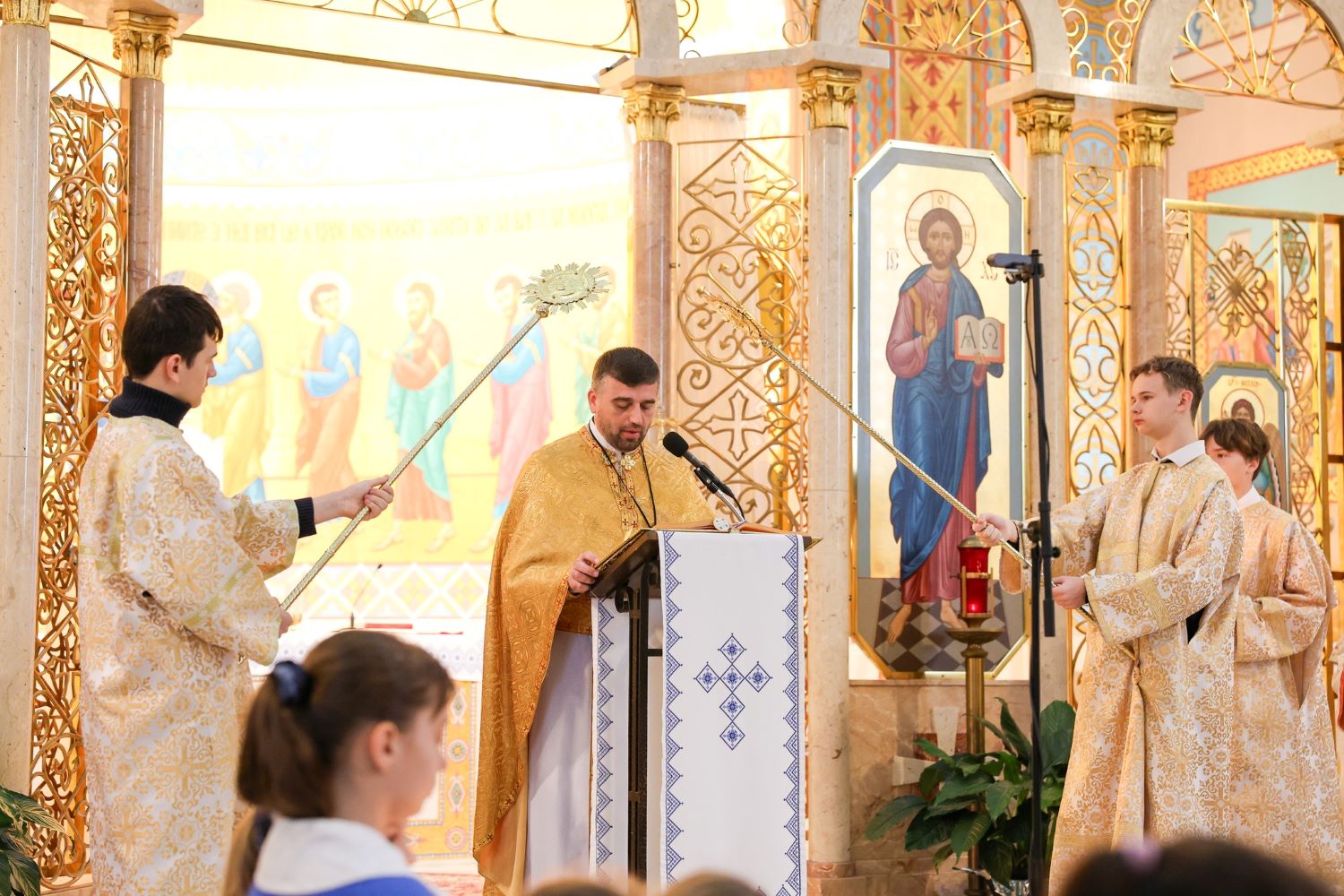355 After his baptism by John in the Jordan, Jesus began his preaching, crying out: “The time is fulfilled, and the kingdom of God has come near; repent, and believe in the good news” (Mk 1:15). He preaches the kingdom for three years and brings it to fruition in the Paschal Mystery.
At the Mystical Supper, Christ gave the apostles a share in the kingdom-his divine life-through the Word and the Eucharist.
356 This joining of the Word and the Mystery is not a coincidence. As the Mother of God first received the Word into her heart and united herself to him, so also we receive the Word into our hearts and put it into practice when we join ourselves to him in the mystery of Communion: “My mother and my brothers are those who hear the word of God and do it” (Lk 8:21; see Mt 12:50 and Mk 3:35). This is why in the Divine Liturgy Christ feeds us first with his Word (in the Epistle, the Gospel, and the homily), and then with his Body and Blood (Communion).
357 We approach the Liturgy of the Word not as a simple recollection of Christ’s preaching long ago, but rather as the living Word. Christ continues to preach today, and we not only read this Word but also receive it as nourishment (see Lk 24:13-34). Through the proclaimed and preached Word in the liturgical assembly, Christ himself addresses the whole Church community and every member individually.
The Exclamation “Blessed be the Kingdom” and the Litany of Peace
358 As the public activity of Christ began with the proclamation that God’s kingdom was at hand, so the Liturgy begins with the announcement that the kingdom is present. Signing the Holy Table with the Gospel Book cross-wise, the priest exclaims: “Blessed be the kingdom of the Father, and of the Son, and of the Holy Spirit, now and for ever and ever.” To this the participants at the Liturgy respond: “Amen” (from the Hebrew, meaning let it be so). By this response they assert that the kingdom is truly among us and that they long for it to thrive and grow.
359 In the Litany of Peace we bring before the Lord the Church’s prayer for the whole world. This is the way the liturgical assembly affirms the manifestation of God’s kingdom. The Church’s prayer for the world is an expression of faith that all is in the hands of the Lord. It also expresses our readiness to accept from the Lord whatever answer he might wish to give. The name of the Litany of Peace indicates the need for inner peace and reconciliation with all. The first petition of the Litany indicates that Christ himself is our peace (see Eph 2:14) and that it is in him that we pray. The petitions of the Litany of Peace express concern for the good of the Church, of the country in which we live, and of all creation. The Litany of Peace teaches the faithful to place common needs before private ones. The prayer “Lord, have mercy,” repeated by the faithful as the community’s response to the petitions, includes both the request for God’s merciful love and the community’s faith that he unfailingly proffers that love.
The Antiphons of the Liturgy
360 The kingdom of God is the fulfilment of all the prophecies and promises of the Old Testament. In order to understand more fully and to accept more intensely the kingdom, we recall these prophecies and promises. We sing psalm verses that express them and a refrain that conveys their fulfilment in Christ. In the solemn hymn, “Only-begotten Son,” we profess that the fulfilment of all that God promised is to be found in the Incarnation and Paschal Mystery of Christ. By singing the refrains “Through the prayers of the Mother of God…” and “Through the prayers of your saints…” we unite ourselves to those in whom this salvation has already been accomplished. This type of singing of the psalms with a refrain is called antiphonal because two alternating choirs (krylosy or scholae) sing them. In the Divine Liturgy there are three antiphons ending with the Little Entrance. In the prayers between the antiphons we profess God’s “love for mankind which is beyond expression” and Christ’s promise to “grant the request of two or three who join their voices in [his] name.”
The Little Entrance, the Troparia, and the Thrice-Holy Hymn
361 While in the singing of the antiphons we experience anticipation of the kingdom and our drawing near to it, the Little Entrance shows that by following Christ we already enter the kingdom; we enter heaven, the fullness of God’s life. Thus, we pray: “Grant that as we make our entrance, the holy angels may enter too, serving with us and joining in the praise of Your goodness.” By the words “Wisdom! Stand aright!” the deacon calls us to direct our attention to the Word of God. The faithful respond by venerating his Wisdom, which is manifested in the Gospel Book. They prepare their hearts to receive the Word during its proclamation. Thus, bowing their heads, the faithful sing: “Come, let us worship and fall down before Christ.”
362 The priest enters the sanctuary with the Gospel Book. This is a sign that it is Jesus Christ, the only High Priest, who celebrates the Divine Liturgy. Christ is invisibly among us, and it is he who leads us to the altar (just as the Gospel Book carried by the deacon precedes everyone). The bishop or priest represents the eternal High Priest who offered the perfect sacrifice once and for all, ascended to heaven, and entered the heavenly sanctuary, sits at the right hand of the Father (see Heb 9:11-14, 23-28).
363 Then follow the troparia and kontakia. These are hymns in honour of a feast or saint, with invocations to Christ, the Mother of God, or saints, and they frequently reveal the theological substance of a feast or commemoration. Thus the Church celebrates and manifests the unfathomable paths by which the Lord led, and continues to lead, each of the faithful into his kingdom.
364 We express our entrance into the kingdom, our being raised to heaven, and our contemplation of the Most Holy Trinity in the words of the Thrice-Holy Hymn: “Holy God, Holy and Mighty, Holy and Immortal, have mercy on us.” Thus we join the heavenly choirs in their singing. In the Prayer of the Thrice-Holy Hymn “standing before the glory of [the] holy altar,” we entreat the Lord to “accept from the lips of us sinners the Thrice-Holy Hymn and visit us in [his] kindness.”
365 During the singing of the Thrice-Holy Hymn, the hierarch ascends the “throne on high.” As the Epistle is read, the bishop is seated on his throne (in Greek, cathedra), along with the priests to his right and to his left. They thus represent Jesus Christ among the apostles, and symbolize the authoritative teaching ministry of the Church.
Hearing the Word of God, Responding to It, and Prayer
366 By his Word the Lord created the world; by his Word at Sinai he called to ministry his Chosen People; in the incarnate Word he gave his people salvation. We are called to receive the Word of God and to answer to it in faith: “All the words that the LORD has spoken we will do!” (Ex 24:3). To truly hear the Word of God means to act on it: “Blessed rather are those who hear the word of God and obey it!” (Lk 11:28). Those who listened to John in the desert and those who listened to Peter on the day of Pentecost asked: “What then shall we do?” (Lk 3:10; Acts 2:37). When we respond to the Word, we receive its life-giving power and, as did the Mother of God, we preserve it in our hearts and flesh it in our lives.
367 The Word of God shines in our hearts “the pure light of … Divine knowledge,” as the Prayer before the Gospel teaches us. To hear the Word of God means “to understand the message of [the] Gospel” in order to accept it as “blessed commandments that we may subdue all carnal desires and follow a spiritual way of life, thinking and doing all that pleases” God. We incline our heads during the reading of the Gospel as a sign of reverent listening and acceptance of the Word of God, In the homily, the priest proclaims the Good News about the mighty deeds of God, calls us to embody the Word we hear: “[He] instructs and exhorts [us] to the imitation of these good things. “290 The faithful listen to the Word of God, which the Lord addresses to them through the reading of the Epistle and Gospel, and through the homily. They receive the Word of God into their hearts as a seed that should bring forth good fruit in their lives. Receiving in this way communion in Christ the Word, they become its bearers and heralds.
368 In the Insistent Litany, the Church prays “that we may be accounted worthy, having learned the truth, by our deeds also to be found good citizens and guardians of what is commanded, so that we may be saved with eternal salvation. “291 Whereas in the Litany of Peace at the beginning of the Liturgy we prayed for the whole world, in the Insistent Litany we mention the faithful by name, we add the special petitions of the assembly in response to the received Word of God, and we entreat God’s help for the different circumstances in the lives of the faithful.
369 In the Litany for the Catechumens, the faithful pray for those preparing for Baptism. They pray that the Lord would “teach them by the word of truth” and (during the second half of Lent) that the Lord “number them among [his] chosen flock.” The catechumens were admitted to the Banquet of the Word in order to help them achieve spiritual maturity and heal spiritual illnesses. Before the beginning of the Banquet of the Eucharist, however, they were dismissed. “Only the faithful” (the baptized) remained, those who had gathered to be nourished by the food of eternal life the Body and Blood of our Lord Jesus Christ.
Source: Catechism Christ our Pascha



